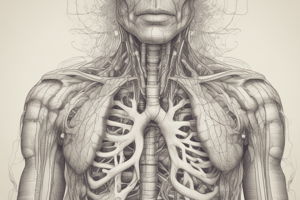Podcast
Questions and Answers
What is the maximum volume of air that can be exhaled after a normal exhalation?
What is the maximum volume of air that can be exhaled after a normal exhalation?
- Residual Volume
- Expiratory Reserve Volume (correct)
- Vital Capacity
- Inspiratory Capacity
Which lung disorder is characterized by airway constriction and chronic inflammation?
Which lung disorder is characterized by airway constriction and chronic inflammation?
- COPD
- Cystic Fibrosis
- Pneumonia
- Asthma (correct)
What is the sum of expiratory reserve volume and residual volume known as?
What is the sum of expiratory reserve volume and residual volume known as?
- Functional Residual Capacity (correct)
- Total Lung Capacity
- Inspiratory Capacity
- Vital Capacity
How is total lung capacity defined?
How is total lung capacity defined?
Which factor can lead to an increased respiratory rate due to lower oxygen levels?
Which factor can lead to an increased respiratory rate due to lower oxygen levels?
What is the primary function of the respiratory system?
What is the primary function of the respiratory system?
Which structure prevents the collapse of the trachea?
Which structure prevents the collapse of the trachea?
During inhalation, which muscles contract to help expand the thoracic cavity?
During inhalation, which muscles contract to help expand the thoracic cavity?
What drives the diffusion of oxygen from the alveoli into the blood?
What drives the diffusion of oxygen from the alveoli into the blood?
Which part of the brain regulates the rate and depth of breathing?
Which part of the brain regulates the rate and depth of breathing?
Where does gas exchange primarily occur within the respiratory system?
Where does gas exchange primarily occur within the respiratory system?
What is tidal volume?
What is tidal volume?
Which of the following is NOT a role of chemoreceptors in controlling respiration?
Which of the following is NOT a role of chemoreceptors in controlling respiration?
Flashcards
Expiratory Reserve Volume
Expiratory Reserve Volume
The maximum volume of air that can be exhaled after a normal exhalation.
Residual Volume
Residual Volume
The volume of air remaining in the lungs after a maximal exhalation.
Inspiratory Capacity
Inspiratory Capacity
The sum of tidal volume and inspiratory reserve volume.
Functional Residual Capacity
Functional Residual Capacity
Signup and view all the flashcards
Vital Capacity
Vital Capacity
Signup and view all the flashcards
Respiratory System
Respiratory System
Signup and view all the flashcards
Nasal Cavity
Nasal Cavity
Signup and view all the flashcards
Alveoli
Alveoli
Signup and view all the flashcards
Inhalation (Inspiration)
Inhalation (Inspiration)
Signup and view all the flashcards
Exhalation (Expiration)
Exhalation (Expiration)
Signup and view all the flashcards
Diffusion
Diffusion
Signup and view all the flashcards
Medulla Oblongata
Medulla Oblongata
Signup and view all the flashcards
Tidal Volume
Tidal Volume
Signup and view all the flashcards
Study Notes
Introduction
- The respiratory system facilitates gas exchange, taking in oxygen and releasing carbon dioxide.
- This process is vital for cellular respiration, powering bodily functions.
Components of the Respiratory System
- Nasal Cavity: Warms, humidifies, and filters inhaled air. Hairs and mucus trap particles.
- Pharynx (Throat): A passageway for air and food.
- Larynx (Voice Box): Houses vocal cords, producing sound.
- Trachea (Windpipe): A rigid tube carrying air. C-shaped cartilage rings prevent collapse.
- Bronchi: Two branches leading to the lungs.
- Bronchioles: Smaller subdivisions of the bronchi.
- Alveoli: Tiny air sacs in the lungs, sites of gas exchange. Surrounded by capillaries.
Process of Respiration
- Inhalation (Inspiration): The diaphragm contracts, flattening and expanding the thoracic cavity. External intercostal muscles elevate ribs, further expanding the cavity and reducing pressure, drawing air into the lungs.
- Exhalation (Expiration): The diaphragm relaxes, returning to its dome shape. The rib cage descends, decreasing thoracic cavity volume and increasing pressure, forcing air out of the lungs.
Gas Exchange
- Diffusion: Oxygen diffuses from alveoli into capillaries; carbon dioxide diffuses from capillaries into alveoli.
- Pressure Differences: Higher oxygen pressure in alveoli drives oxygen into blood. Conversely, higher carbon dioxide pressure in blood drives it into alveoli.
Control of Respiration
- Medulla Oblongata: Contains respiratory rhythmicity centers, controlling breathing rate and depth.
- Chemoreceptors: Detect changes in blood oxygen, carbon dioxide, and pH levels, influencing the medulla.
- Peripheral Chemoreceptors: Located in carotid and aortic bodies, monitoring blood gas levels and pH, signaling respiratory centers.
Lung Volumes and Capacities
- Tidal Volume: Air inhaled or exhaled during a normal breath.
- Inspiratory Reserve Volume: Air inhaled beyond a normal breath.
- Expiratory Reserve Volume: Air exhaled beyond a normal breath.
- Residual Volume: Air remaining in lungs after maximal exhalation.
- Inspiratory Capacity: Tidal volume plus inspiratory reserve volume.
- Functional Residual Capacity: Expiratory reserve volume plus residual volume.
- Vital Capacity: Maximum air moved in and out of lungs in a single breath.
- Total Lung Capacity: Sum of all lung volumes.
Disorders of the Respiratory System
- Asthma: Chronic inflammatory disorder causing airway constriction, reducing airflow.
- COPD (Chronic Obstructive Pulmonary Disease): Progressive lung diseases (emphysema, chronic bronchitis), hindering breathing.
- Pneumonia: Lung inflammation, often infection-related.
- Tuberculosis (TB): Infectious disease affecting the lungs.
- Cystic Fibrosis: Genetic disorder affecting mucus production, increasing susceptibility to respiratory infections.
Factors Affecting Respiration
- Exercise: Increases oxygen demand, leading to increased respiratory rate and depth.
- Altitude: Lower oxygen levels at high altitudes increase breathing to compensate.
- Disease: Many diseases impact respiratory function.
- Age: Respiratory function typically declines with age, reduced lung elasticity affecting gas exchange.
Studying That Suits You
Use AI to generate personalized quizzes and flashcards to suit your learning preferences.




